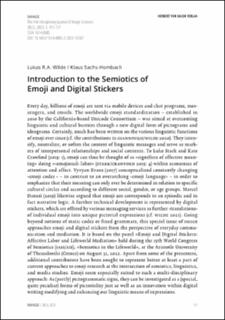| dc.contributor.author | Wilde, Lukas R.A. | |
| dc.contributor.author | Sachs-Hombach, Klaus | |
| dc.date.accessioned | 2024-04-16T08:18:38Z | |
| dc.date.available | 2024-04-16T08:18:38Z | |
| dc.date.created | 2024-03-19T09:25:59Z | |
| dc.date.issued | 2023 | |
| dc.identifier.citation | IMAGE: The Interdisciplinary Journal of Image Sciences. 2023, 38 (2), ?-151. | en_US |
| dc.identifier.issn | 2362-4981 | |
| dc.identifier.uri | https://hdl.handle.net/11250/3126699 | |
| dc.description.abstract | Every day, billions of emoji are sent via mobile devices and chat programs, messengers, and emails. The worldwide emoji standardization – established in 2010 by the California-based Unicode Consortium – was aimed at overcoming linguistic and cultural barriers through a new digital form of pictograms and ideograms. Certainly, much has been written on the various linguistic functions of emoji ever since (cf. the contributions in GIANNOULIS/WILDE 2020). They intensify, neutralize, or soften the content of linguistic messages and serve as markers of interpersonal relationships and social contexts. To Luke Stark and Kate Crawford (2015: 1), emoji can thus be thought of as »signifiers of affective meaning« doing »›emojional‹ labor« (STARK/CRAWFORD 2015: 4) within economies of attention and affect. Vyvyan Evans (2017) conceptualized constantly changing ›emoji codes ‹ – in contrast to an overarching ›emoji language‹ – in order to emphasize that their meaning can only ever be determined in relation to specific cultural circles and according to different social, gender, or age groups. Marcel Danesi (2019) likewise argued that emoji use corresponds to an episodic and in fact narrative logic. A further technical development is represented by digital stickers, which are offered by various messaging services as further ›translations‹ of individual emoji into unique pictorial expressions (cf. WILDE 2021). Going beyond notions of static codes or fixed grammars, this special issue of IMAGE approaches emoji and digital stickers from the perspective of everyday communication and mediation. It is based on the panel »Emoji and Digital Stickers: Affective Labor and Lifeworld Mediation« held during the 15th World Congress of Semiotics (IASS/AIS), »Semiotics in the Lifeworld«, at the Aristotle University of Thessaloniki (Greece) on August 31, 2022. Apart from some of the presenters, additional contributors have been sought to represent better at least a part of current approaches to emoji research at the intersection of semiotics, linguistics, and media studies. Emoji seem especially suited to such a multi-disciplinary approach: As (partly) pictogrammatic signs, they can be investigated as a (special, quite peculiar) forms of pictoriality just as well as an innovation within digital writing modifying and enhancing our linguistic means of expressions. | en_US |
| dc.description.abstract | Introduction to the Semiotics of Emoji and Digital Stickers | en_US |
| dc.language.iso | eng | en_US |
| dc.publisher | Herbert von Halem Verlag | en_US |
| dc.relation.uri | https://image-journal.de/introduction-to-the-semiotics-of-emoji-and-digital-stickers/ | |
| dc.rights | Navngivelse 4.0 Internasjonal | * |
| dc.rights.uri | http://creativecommons.org/licenses/by/4.0/deed.no | * |
| dc.title | Introduction to the Semiotics of Emoji and Digital Stickers | en_US |
| dc.title.alternative | Introduction to the Semiotics of Emoji and Digital Stickers | en_US |
| dc.type | Journal article | en_US |
| dc.description.version | publishedVersion | en_US |
| dc.source.volume | 38 | en_US |
| dc.source.journal | IMAGE: The Interdisciplinary Journal of Image Sciences | en_US |
| dc.source.issue | 2 | en_US |
| dc.identifier.doi | 10.1453/1614-0885-2-2023-15747 | |
| dc.identifier.cristin | 2255605 | |
| cristin.ispublished | true | |
| cristin.fulltext | original | |

